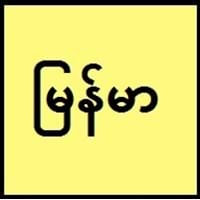Countries
Hong Kong, Macau
Myanmar
National Language
China, Guangdong
Myanmar
Second Language
Not spoken in any of the countries
Bangladesh, Burma
Speaking Continents
Asia
Asia
Minority Language
Hawaii
Mon
Regulated By
Civil Service Bureau, Government of Hong Kong, Official Language Division
Myanmar Language Commission
Interesting Facts
- Cantonese have lot of slangs, many of them include words that do not make sense at all and some also have English in them.
- Even though Cantonese and Mandarin are dialects of Chinese, Cantonese has 8 tones instead of Mandarin's 4.
- The naming of people in Burmese is strange. There is no last name, often name is rhymed such as Ming Ming, Mo Mo or Jo Jo.
- It appears as odd language to many people because it has peculiar pitch register, tonal form as language.
Similar To
Chinese Language
Thai Language
Derived From
Not Available
Pali Language
Alphabets in
Cantonese-Alphabets.jpg#200
Burmese-Alphabets.jpg#200
Scripts
Chinese Characters and derivatives
Tangut
Writing Direction
Left-To-Right, Horizontal, Top-To-Bottom
Left-To-Right, Horizontal
Hello
您好
မင်္ဂလာပါ (maingalarpar)
Thank You
谢谢
ကျေးဇူးတင်ပါသည် (kyaayyjuutainparsai)
How Are You?
你好吗?
နေကောင်းလား? (naykaungglarr?)
Good Night
晚安
ကောင်းသောညပါ (kaunggsawnyapar)
Good Evening
晚上好
မင်္ဂလာညနေခင်းပါ (main g lar nyanayhkainn par)
Good Afternoon
下午好
မင်္ဂလာနေ့လည်ခင်းပါ (main g lar naelaihkainn par)
Good Morning
早上好
မင်္ဂလာနံနက်ခင်းပါ (main g lar nannaathkainnpar)
Please
请
ကျေးဇူးပြု (kyaayyjuupyu)
Sorry
遗憾
တောင်းပန်ပါတယ် (taunggpaanpartaal)
Bye
再见
နုတ်ဆက်ပါတယ် (notesaatpartaal)
I Love You
我爱你
မင်းကိုချစ်တယ် (mainnkohkyittaal)
Excuse Me
原谅我
ဆင်ခြေဆင်လက် ငါ့ကိုအ (Sainhkyaysainlaat ngarko a)
Dialect 1
Guangzhou
Arakanese
Where They Speak
outside mainland China
Bangladesh, India, Myanmar
How Many People Speak
Not Available
Where They Speak
Hong Kong
Myanmar
How Many People Speak
Not Available
Dialect 3
Hong Kong
Intha
Where They Speak
Hong Kong
Burma
How Many People Speak
Not Available
Second Language Speakers
Not Available
Native Name
Kwang Tung Wa
ဗမာစကား (bama saka)
Alternative Names
Guangfu, Metropolitan Cantonese
Bama, Bamachaka, Myanmar, Myen, myanma bhasa
French Name
Not Available
birman
German Name
Not Available
Birmanisch
Pronunciation
Not Available
Not Available
Ethnicity
Not Available
Bamar people
Origin
17th century
1113 AD
Language Family
Sino-Tibetan Family
Sino-Tibetan Family
Subgroup
Not Available
Tibeto-Burman
Branch
Not Available
Not Available
Early Forms
No early forms
Old Burmese, Middle Burmese, Burmese
Standard Forms
Standard Cantonese
Modern Burmese
Language Position
Not Available
Signed Forms
Not Available
Burmese sign language
Scope
Not Available
Individual
ISO 639 1
No data available
my
ISO 639 2/T
Not Available
mya
ISO 639 2/B
Not Available
bur
ISO 639 3
No data available
mya
ISO 639 6
Not Available
Not Available
Glottocode
cant1236
sout3159
Linguasphere
No data available
No data available
Language Type
Not Available
Living
Language Linguistic Typology
Not Available
Subject-Object-Verb
Language Morphological Typology
Not Available
Analytic, Isolating
All Cantonese and Burmese Dialects
Most languages have dialects where each dialect differ from other dialect with respect to grammar and vocabulary. Here you will get to know all Cantonese and Burmese dialects. Various dialects of Cantonese and Burmese language differ in their pronunciations and words. Dialects of Cantonese are spoken in different Cantonese Speaking Countries whereas Burmese Dialects are spoken in different Burmese speaking countries. Also the number of people speaking Cantonese vs Burmese Dialects varies from few thousands to many millions. Some of the Cantonese dialects include: Guangzhou, Xiguan. Burmese dialects include: Arakanese , Tavoyan. Also learn about dialects in South American Languages and North American Languages.
Cantonese and Burmese Speaking population
Cantonese and Burmese speaking population is one of the factors based on which Cantonese and Burmese languages can be compared. The total count of Cantonese and Burmese Speaking population in percentage is also given. The percentage of people speaking Cantonese language is 16.00 % whereas the percentage of people speaking Burmese language is 0.50 %. When we compare the speaking population of any two languages we get to know which of two languages is more popular. Find more details about how many people speak Cantonese and Burmese on Cantonese vs Burmese where you will get native speakers, speaking population in percentage and native names.
Cantonese and Burmese Language Codes
Cantonese and Burmese language codes are used in those applications where using language names are tedious. Cantonese and Burmese Language Codes include all the international language codes, glottocodes and linguasphere.





